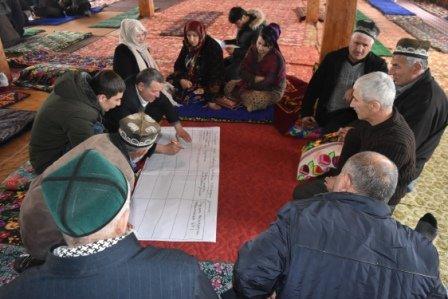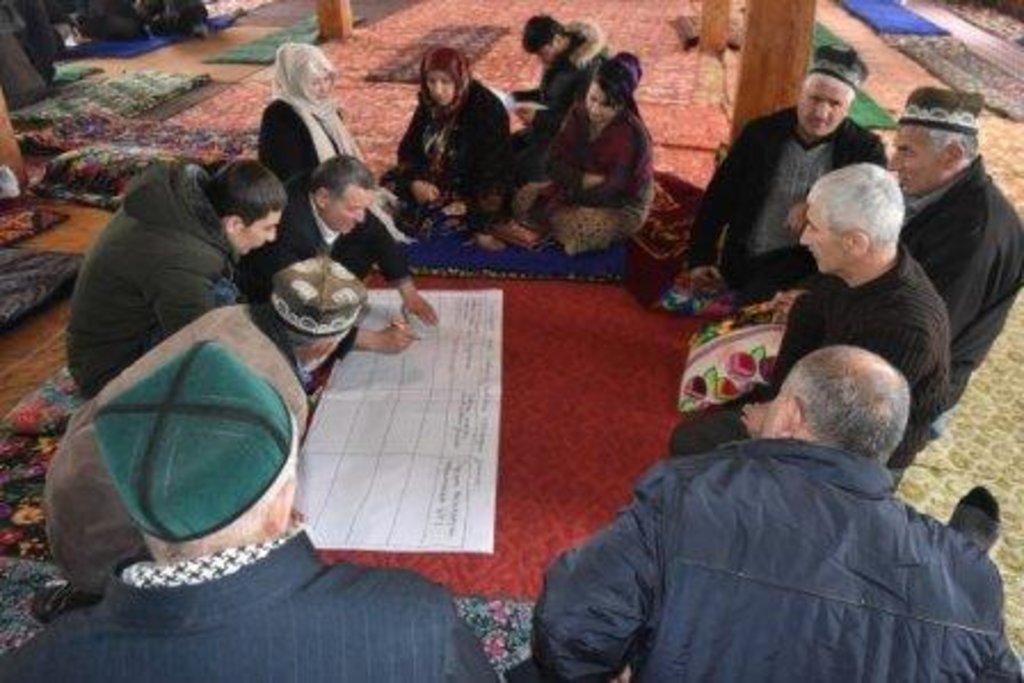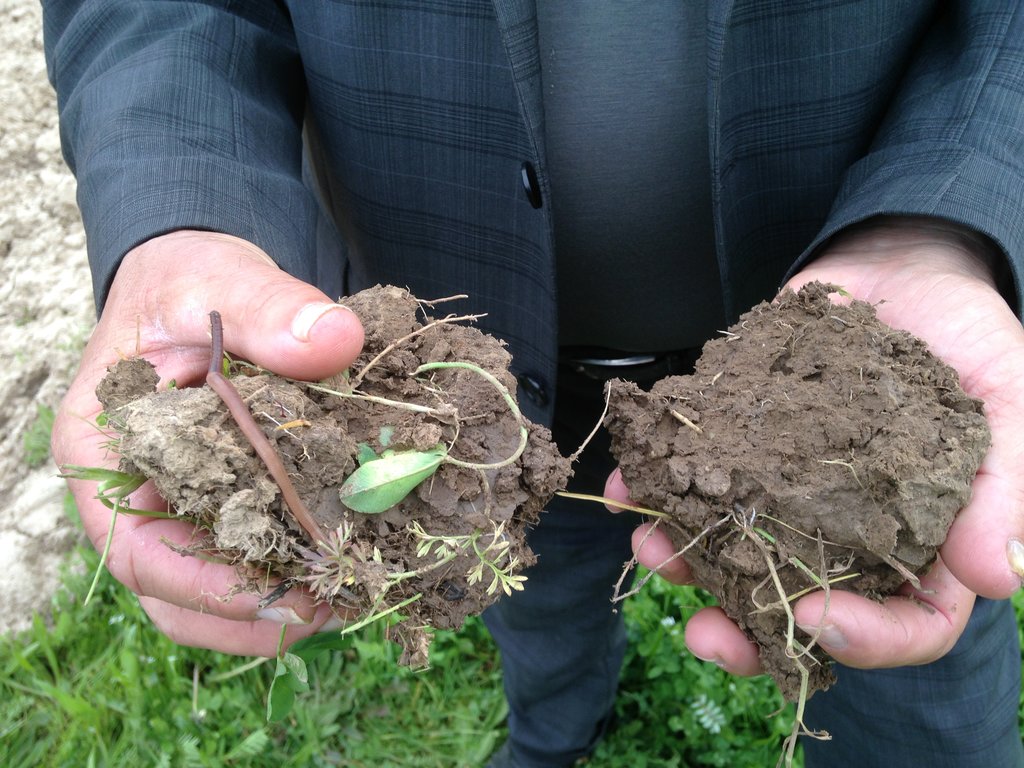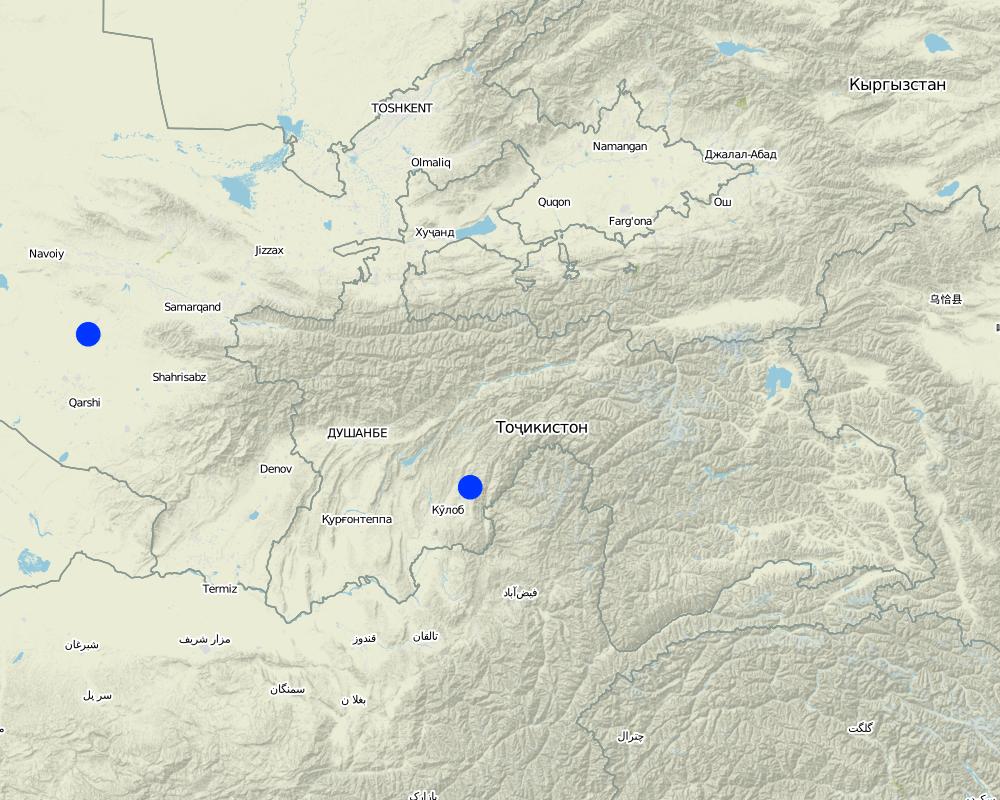Participatory Land use planning and assessment [Tajiquistão]
- Criação:
- Atualização:
- Compilador/a: Askarsho Zevarshoev
- Editor: –
- Revisor: Farrukh Nazarmavloev
Накшаи муштараки истифодабари ва бахогузории замин
approaches_3635 - Tajiquistão
Veja as seções
Expandir tudo Recolher tudo1. Informação geral
1.2 Detalhes do contato das pessoas capacitadas e instituições envolvidas na avaliação e documentação da abordagem
Nome do projeto que facilitou a documentação/avaliação da Abordagem (se relevante)
Integrated Health and Habitat Improvement in Rasht Valley, TajikistanNome da(s) instituição(ões) que facilitou(ram) a documentação/avaliação da Abordagem (se relevante)
Aga Khan Foundation (AKF) - Suíça1.3 Condições em relação ao uso da informação documentada através de WOCAT
Quando os dados foram compilados (no campo)?
25/07/2017
O compilador e a(s) pessoa(s) capacitada(s) aceitam as condições relativas ao uso de dados documentados através do WOCAT:
Sim
1.4 Referência ao(s) questionário(s) sobre tecnologias da GST
2. Descrição da abordagem de GST
2.1 Descrição curta da abordagem
Participatory Land Use Planning and Assessment is an inter disciplinary approach to the land use with combination of the modern tools and community knowledge to identify land degradations with its intensity and trends and through this approach design intervention directed toward land degradation prevention. This approach also compiles different tools including PRA and soil assessment and LADA techniques in a participatory manner. The approach address issues with all categories of land use including crop and pasture land, forest and even settlement with regards to natural disaster consideration for construction.
2.2 Descrição detalhada da abordagem
Descrição detalhada da abordagem:
As a precondition to the development of evidence- and needs-based plans, Participatory Land Use Planning and Assessment (PLUPA) will be conducted, with participation of local specialists, to assess sub-watershed natural and human-induced hazards and natural resource conditions, and IHA results will be presented to community and local government stakeholders to foster ownership. The outcome will improve community involvement in development by enhancing the ability to conduct local development planning and implementation.
Attention will be given to promoting the role of women in local development.
The PLUPA will employ terrestrial inspection of the land using simplified tools based on the WOCAT questionnaire for the land management technologies. The field-based assessment will include physical inspection of the land use and collecting necessary data like GPS points and information on target watershed (e.g. availability of pastureland, natural hazards, public and private infrastructure). The remote sensing component will be used for analyzing images and identification of trend analysis as well erosion on soil, land degradation.
Communities (via CSOs) and local governments are involved in conducting PLUPA, and will drive and own the result for development of their plan at watershed level. They will also be core stakeholders in the prioritization of water, health, and NRM interventions as per watershed management plan, and will be partners and contributors (including financially) in construction and management of new infrastructure post-project. This fosters commitment and ownership, promoting development that is accountable, participatory, inclusive, transparent, and efficient.
2.3 Fotos da abordagem
Observações gerais sobre as fotos:
Two sample of soils from one plot where the land used for different purposes
2.5 País/região/locais onde a abordagem foi aplicada
País:
Tajiquistão
Map
×2.6 Datas de início e término da abordagem
Caso o ano exato seja desconhecido, indique a data aproximada de início da abordagem:
menos de 10 anos atrás (recentemente)
2.7 Tipo de abordagem
- Baseado em projeto/programa
2.8 Principais metas/objetivos da abordagem
The main goal of the approach is to bring together stakeholders to use simplified methods on soil assessment and raise awareness on the importance of soil health for production. Based on that approach communities will design action for better management of their land and soil conservaiton
2.9 Condição que propiciam ou inibem a implementação de tecnologia/tecnologias aplicada(s) segundo a abordagem
Normas e valores sociais/culturais/religiosos
- Inibitivo
people are not organized well and land use planning is taking place on a add-hoc basis. traditional knowledge, which is bind to local culture and social norms is lost with applying pre-modern agriculture practice for what community does not have proper access to resources, such as inputs and tehcnology
Quadro institucional
- Propício
Quadro jurídico (posse de terra, direitos de uso da terra e da água)
- Propício
farmers are organized in a legal structure, which is make them compliant to the land rights and supported with planning for land use
Conhecimento sobre GST, acesso a suporte técnico
- Inibitivo
not all farmers, which got land have farming knowledge and practices on SLM. Basic practices which they learn from other farmer or inherited from their generation.
Mercados (para comprar entradas, vender produtos) e preços
- Propício
there is a lot of demand for food products in the markets and existing service providers who supply inputs. If land use planning is organized in a good way community will get good benefit from farming.
3. Participação e papel das partes interessadas envolvidas
3.1 Partes interessadas envolvidas na abordagem e seus papéis
- Usuários de terra/comunidades locais
land users, forest user, pasture users,
plan and provide field based knowledge on land use practices
- Organizações comunitárias
village organization and different initiative groups with regards to land use
support with mobilizing communities for better planning of the land resource and motivate collaboration between different land users
- Especialistas em GST/ consultor agrícola
land management, forest, pasture specialist from related department of government
support with providing technical knowledge and solving the current land use issues with applying/providing good practices
- Governo local
sub-district and district level
facilitate the process of collaboration among different land users and make decision on future perspective of land use
3.2 Envolvimento do usuários de terra/comunidades locais nas diferentes fases da abordagem
| Envolvimento do usuários de terra/comunidades locais | Especifique quem estava envolvido e descreva as atividades | |
|---|---|---|
| Iniciação/motivação | Apoio externo | land users of different categories, including pasture users, forest user etc,. come together to discuss the future land use perspective and decide on organizing themselves in better management of their land resources |
| Planejamento | Participativo | all stakeholders involved and support different perspective of land use categories and jointly plan for the future land use |
| Implementação | Apoio externo | all stakeholders, involved in different land use categories negotiate and agree on terms and condition with regards complement the different land use importance. |
| Monitoramento/avaliação | Passivo | all stakeholders are passive in following the progress and results from land use intervention. |
3.4 Decisão sobre a seleção de tecnologia/tecnologias de GST
Especifique quem decidiu sobre a seleção de tecnologia/tecnologias a serem implementadas:
- Principalmente especialistas em GST, após consulta com usuários da terra
Explique:
the approach is introduced in the framework of the projects and only SLM specialists consult on the tools and approach how to plan
Especifique em que base foram tomadas as decisões:
- Avaliação de conhecimento bem documentado de GST (tomada de decisão baseada em evidências)
4. Suporte técnico, reforço das capacidades e gestão do conhecimento
4.1 Reforço das capacidades/formação
Foi oferecida formação aos usuários da terra/outras partes interessadas?
Sim
Especifique quem foi capacitado:
- Usuários de terra
- Equipe de campo/consultores
Caso seja relevante, especifique gênero, idade, status, etnia, etc.
training on soil assessment, land management and participatory land use planning and assessment
Tipo de formação:
- Em exercício
- Reuniões públicas
Assuntos abordados:
land degradation, soil assessment, land management
4.2 Serviço de consultoria
Os usuários de terra têm acesso a um serviço de consultoria?
Não
4.3 Fortalecimento da instituição (desenvolvimento organizacional)
As instituições foram fortalecidas ou estabelecidas através da abordagem?
- Sim, pouco
Especifique a que nível (níveis) as instituições foram fortalecidas ou estabelecidas:
- Local
Descreva instituição, papéis e responsabilidades, membros, etc.
land use committee under the village organization as small entity dealing with land issues in the community only
Especifique o tipo de apoio:
- Reforço das capacidades/formação
Dê mais detalhes:
land management, land degradation prevention
4.4 Monitoramento e avaliação
Monitoramento e avaliação são partes da abordagem?
Não
4.5 Pesquisa
A pesquisa foi parte da abordagem?
Não
5. Financiamento e apoio material externo
5.1 Orçamento anual para o componente de GST da abordagem
Caso o orçamento exato seja desconhecido, indique a faixa:
- < 2.000
5.2 Apoio financeiro/material concedido aos usuários da terra
Os usuários da terra receberam apoio financeiro/material para a implementação de tecnologia/tecnologias?
Não
5.3 Subsídios para entradas específicas (incluindo mão-de-obra)
- Nenhum
Se a mão-de-obra pelos usuários da terra foi uma entrada substancial, isso foi:
- Voluntário
5.4 Crédito
Foi concedido crédito segundo a abordagem para atividades de GST?
Não
5.5 Outros incentivos ou instrumentos
Foram utilizados outros incentivos ou instrumentos para promover a implementação das tecnologias de GST?
Sim
Caso afirmativo, especifique:
some funding was made available for implementation of action prioritized in the land use planning
6. Análise de impactos e declarações finais
6.1 Impactos da abordagem
A abordagem concedeu autonomia aos usuários locais de terra, melhorou a participação das partes interessadas?
- Não
- Sim, pouco
- Sim, moderadamente
- Sim, significativamente
the process follow by series of capacity building trainings, which are empowering community to get knowledge and understanding
A abordagem propiciou a tomada de decisão baseada em evidências?
- Não
- Sim, pouco
- Sim, moderadamente
- Sim, significativamente
as the approach involve participatory methods decision is made equally by all stockholders, including land users
A abordagem auxiliou os usuários da terra a implementar e manter as tecnologias de GST?
- Não
- Sim, pouco
- Sim, moderadamente
- Sim, significativamente
as a result of the approach action plan with implementing of technologies is involved
A abordagem mobilizou/melhorou o acesso aos recursos financeiros para implementação da GST?
- Não
- Sim, pouco
- Sim, moderadamente
- Sim, significativamente
the approach results in a sophisticated document as plan and assessment report, which will then attracts funding for easy reference
A abordagem atenuou conflitos?
- Não
- Sim, pouco
- Sim, moderadamente
- Sim, significativamente
the plan is mobilize communities and other stakeholder to collaborate and work together and negotiate and resolve emerging conflicts over resource
6.2 Principal motivação dos usuários da terra para implementar a GST
- Produção aumentada
prevention of and application of technologies contribute to improvement of production
- Degradação do solo reduzida
soil conservation techniques will be identified to apply for prevention of land degradation
6.3 Atividades de sustentabilidade de abordagem
Os usuários da terra podem manter o que foi implementado através da abordagem (sem apoio externo)?
- Incerto
Caso negativo ou incerto, especifique e comente:
community are only focused to get maximum economic benefit from land and therefore do not pay enough attention to support ecosystem services or environmental aspect of land conservation
6.4 Pontos fortes/vantagens da abordagem
| Pontos fortes/vantagens/oportunidades na visão do usuário da terra |
|---|
| participatory |
| simply approach applied by community members themselve |
| Pontos fortes/vantagens/oportunidades na visão do compilador ou de outra pessoa capacitada |
|---|
| provides visions, empowers land users to negotiate interventions among them, also raise awareness on the sustainability aspects of land use and provides more aspects on land conservation techniques for land term land use |
6.5 Pontos fracos, desvantagens da tecnologia e formas de superá-los
| Pontos fracos/desvantagens/riscos na visão do usuário da terra | Como eles podem ser superados? |
|---|---|
| time consuming, required a lot of facilitation | more awareness on communities knowledge about long term land use benefits. strengthen local legal framework to sustain and promote the planing process |
| Pontos fracos/vantagens/riscos na visão do compilador ou de outra pessoa capacitada | Como eles podem ser superados? |
|---|---|
| SLM knowledge and capacity | trainings for the local institutes involved in land use planing and management |
7. Referências e links
7.1 Métodos/fontes de informação
- visitas de campo, pesquisas de campo
40
- entrevistas com especialistas em GST
3
7.2 Referências às publicações disponíveis
Título, autor, ano, ISBN:
Participatory Land Use Planning, 2011
Disponível de onde? Custos?
Free of charge, from SLM compiler
Links e módulos
Expandir tudo Recolher tudoLinks
Não há links
Módulos
Não há módulos





